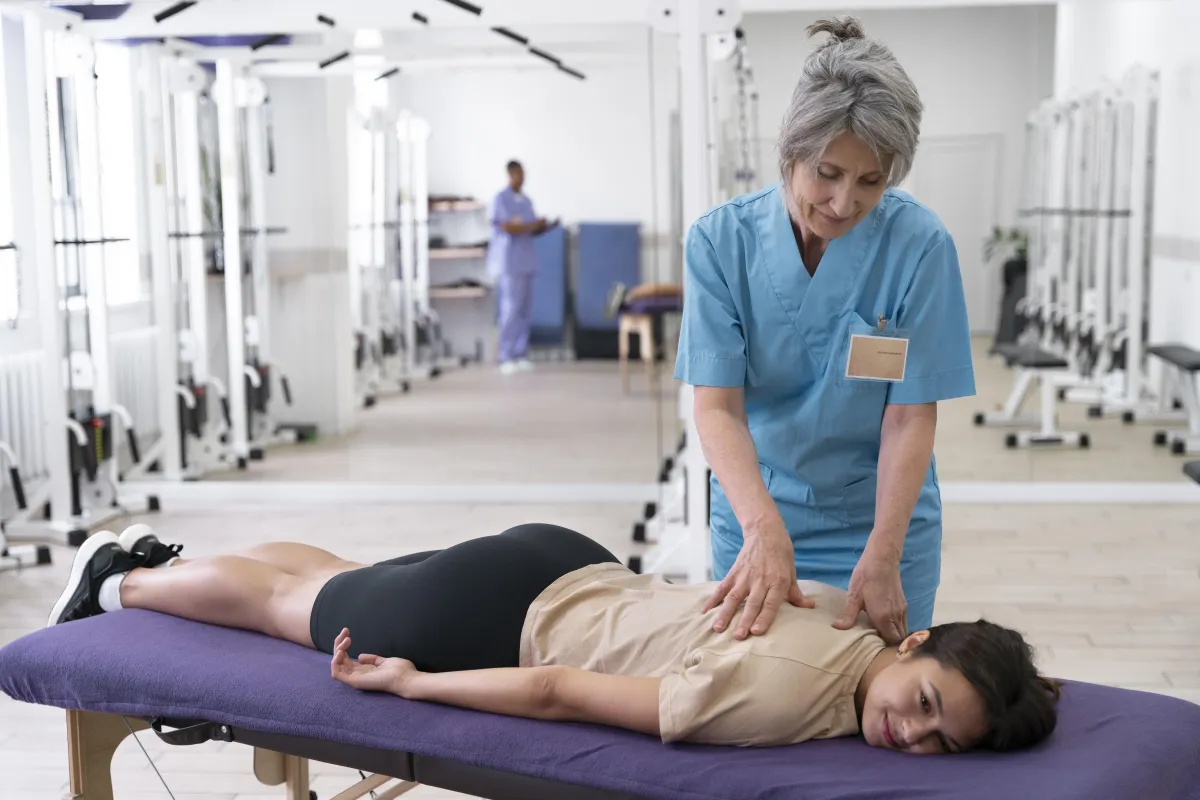Physiotherapy for Herniated Disc Pain in NYC
Manhattan Physical Therapy

What Is a Herniated Disc?
A herniated disc is one of the most common spinal issues affecting adults, with an estimated 3 million cases each year. This condition can cause sharp pain, numbness, or weakness that affects your ability to move freely. Fortunately, physical therapy for herniated disc pain is a proven, non-surgical approach that helps relieve discomfort, restore movement, and prevent future flare-ups.
Your spine is composed of 33 small bones called vertebrae, stacked one on top of another. Between each vertebra lies a disc that acts as a cushion—absorbing shock and supporting spinal movement. Each disc has two parts:
Annulus fibrosus: The tough, outer ring made of layered tissue that keeps the disc stable.
Nucleus pulposus: The soft, gel-like inner core that helps the spine absorb pressure and remain flexible.
A herniated disc occurs when the nucleus pulposus pushes through a tear in the annulus fibrosus. This displacement can irritate or compress nearby spinal nerves, leading to pain, tingling, or weakness in the neck, back, or legs.
What Causes a Herniated Disc?
A herniated disc can result from both gradual and sudden stress on the spine. Over time, age-related changes—known as disc degeneration—cause the discs to lose hydration and elasticity. This makes them more vulnerable to tears, especially with improper posture or repetitive strain.
Common causes include:
Natural wear and tear that reduces disc flexibility.
Lifting heavy objects while twisting or bending improperly.
Jobs or sports that involve frequent pulling, pushing, or twisting motions.
Extra stress on the lower back.
A family history of spinal conditions can increase your risk.
While sudden trauma can occasionally cause a herniated disc, most cases develop slowly from daily habits, posture, or physical strain. The condition most often affects the lower back (lumbar spine), though it can also occur in the neck (cervical spine).
What Are the Signs and Symptoms?
Symptoms of a herniated disc vary depending on the location and severity of the herniation. Some individuals may experience little to no pain, while others find it difficult to perform simple daily activities.
Typical symptoms include:
Pain in the neck, back, arms, or legs
Numbness or tingling in the shoulders, arms, hands, hips, or feet
Weakness in the limbs
Increased pain with coughing, sneezing, or sitting
Difficulty standing straight or walking
Pain that worsens in the morning or after long periods of inactivity
How Is a Herniated Disc Diagnosed?
A physical therapist or physician will begin by reviewing your medical history and discussing your symptoms in detail. They may ask questions such as:
When did your pain begin, and what makes it better or worse?
Do you experience tingling, weakness, or numbness?
How does the pain affect your daily activities?
Afterward, your provider will perform a series of physical tests to assess movement, flexibility, muscle strength, posture, and nerve function. They’ll check for:
Difficulty moving or bending
Muscle weakness or tightness
Reduced reflexes or sensation
Joint stiffness and poor posture
If necessary, diagnostic imaging such as an MRI may be recommended to confirm the presence and extent of the herniation. Early evaluation allows for an accurate diagnosis and a customized treatment plan.
How Can a Physical Therapist Help?
In most cases, physical therapy provides better long-term results for herniated disc pain than surgery or medication. A licensed physical therapist designs a personalized treatment plan to relieve pain, restore function, and strengthen the spine to prevent recurrence.
The primary goals of physical therapy are to:
Reduce pain and inflammation through controlled movements and posture correction.
Restore mobility and flexibility by safely improving spinal and muscular motion.
Strengthen the core and back muscles to support the spine and reduce future stress.
Promote healing through gentle, guided activity instead of prolonged rest.
What Does a Herniated Disc Treatment Program Include?
Your physical therapist will create a customized exercise plan tailored to your individual condition and recovery goals. Not every exercise is suitable for everyone, so your therapist will choose movements that best support your healing.
For instance:
Aquatic therapy is an excellent option for staying active when land-based exercises cause discomfort, as water reduces pressure on the spine.
Twisting or bending movements may be limited or adjusted based on how your body responds to them.
Strength training plays a key role in recovery but must be performed with proper technique to prevent strain on the neck and lower back.
Walking routines are often introduced gradually to help improve endurance and overall mobility.
Recovery and Long-Term Outlook
With consistent physical therapy and adherence to home exercises, most patients recover without surgery. The healing time varies from person to person, but noticeable improvement often occurs within a few weeks of treatment. Long-term success depends on maintaining proper posture, staying active, and following the strengthening program designed for you.
Physical therapy empowers you to understand your body, manage pain naturally, and regain your quality of life. If you’re experiencing symptoms of a herniated disc, consider consulting with a specialist at Manhattan Physical Therapy. Professional care can help you return to a pain-free and active lifestyle.
To book an appointment, call (212)-213-3480 today.
What others are saying
Alexander Liu
"Everyone on the team at Manhattan Physical Therapy is super nice and caring. They were able to pretty quickly diagnose my knee and hip problems and immediately put me to work to reduce the pain.."
Henry Myerberg
"You're not just a patient when you come to the Manhattan Physical Therapy. You feel like family there. In particular, Erica with her colleagues John, Lidia and Joe not only fix and improve you physically, they make you feel welcomed and cared for.."
Hakyung Kim
"Everyone is so kind and helpful! my knee and hip pain have improved massively since starting Manhattan PT, highly recommend to anyone. special thanks to Bianca, Lidia, Joe, and John!"
Manhattan Physical Therapy
✆ Phone (appointments):
(212) 213-3480
Address: 385 5th Ave, Suite 503, New York, NY 10016

